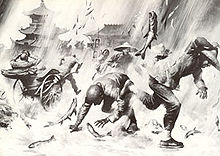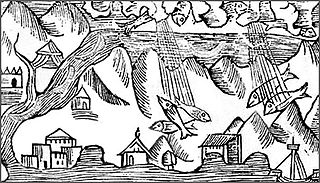Rain of animals
Reported meteorological phenomenon From Wikipedia, the free encyclopedia
Reported meteorological phenomenon From Wikipedia, the free encyclopedia
A rain of animals is a rare meteorological phenomenon in which flightless animals fall from the sky. Such occurrences have been reported in many countries throughout history.[1] One hypothesis is that tornadic waterspouts sometimes pick up creatures such as fish or frogs, and carry them for up to several miles.[1][2] However, this aspect of the phenomenon has never been witnessed by scientists.[3]
You can help expand this article with text translated from the corresponding article in French. Click [show] for important translation instructions.
|


Rain of flightless animals and things has been reported throughout history.[1] In the first century AD, Roman naturalist Pliny the Elder documented storms of frogs and fish.[4] In 1794, French soldiers saw toads fall from the sky during heavy rain at Lalain, near the French city of Lille.[5] Rural inhabitants in Yoro, Honduras claim "fish rain" happens there every summer, a phenomenon they call Lluvia de Peces, although the name may be indoctrination from a Spanish missionary as the fish have only been found near tributaries after storms.[6]

French physicist André-Marie Ampère (1775–1836) was among the first scientists to take accounts of raining animals. Addressing the Society of Natural Science, Ampère suggested that at times frogs and toads roam the countryside in large numbers, and that violent winds could pick them up and carry them great distances.[3]
After a reported rain of fish in Singapore in 1861, French naturalist Francis de Laporte de Castelnau speculated that a migration of walking catfish had taken place, dragging themselves over land from one puddle to another, following the rain.[7]
The likeliest explanation for many of the supposed cases is that there is no falling happening at all and the animals are driven along by winds or a deluge of some sort.[8] This explanation also accounts for the prevalence of reports that only a single species or type of animal is ever reported raining from the sky. On October 24, 1987(several occurrences within two weeks), three towns of Gloucestershire, England named, Stroud, Cirencester, and Cheltenham reported, by various people, about a heavy rain fall that also brought down dozens of tiny pink frogs. Some suggested strong winds, waterspouts, or tornados carried the frogs' eggs flying north across Africa, until falling on England.[9]
A current scientific hypothesis involves tornadic waterspouts: a tornado that forms over the water.[1][10][11][12] Under this hypothesis, a tornadic waterspout transports animals to relatively high altitudes, carrying them over large distances. This hypothesis appears supported by the type of animals in these rains: small and light, usually aquatic,[13] and by the suggestion that the rain of animals is often preceded by a storm. However, the theory does not account for how all the animals involved in each individual incident would be from only one species, and not a group of similarly sized animals from a single area.[14] Further, the theory also does not account for a genuine tornadic waterspout not actually sucking objects up and carrying them rather than flinging objects out to the sides.[15]

In the case of birds, storms may overcome a flock in flight, especially in times of migration. The Doppler image to the right shows an example wherein a group of bats is overtaken by a thunderstorm.[16] In the image, the bats are in the red zone, which corresponds to winds moving away from the radar station, and enter into a mesocyclone associated with a tornado (in green). These events may occur easily with birds, which can get killed in flight, or stunned and then fall (unlike flightless creatures, which first have to be lifted into the air by an outside force). Sometimes this happens in large groups, for instance, the blackbirds falling from the sky in Beebe, Arkansas, United States on December 31, 2010.[17] It is common for birds to become disoriented (for example, because of bad weather or fireworks) and collide with objects such as trees or buildings, killing them or stunning them into falling to their death. The number of blackbirds killed in Beebe is not spectacular considering the size of their congregations, which can be in the millions.[18] The event in Beebe, however, captured the imagination and led to more reports in the media of birds falling from the sky across the globe, such as in Sweden and Italy,[19] though many scientists claim such mass deaths are common occurrences but usually go unnoticed.[20] In contrast, it is harder to find a plausible explanation for rains of terrestrial animals.
Some cases are thought to be caused by birds dropping fish. With regard to a documented rain of fish that occurred on December 29, 2021 in Texarkana, Texas. Several residents of a landlocked city, in east Texas have reported a rare sight seeing fish all over the ground after they apparently fell from the sky during a rainstorm. Independent researchers, Sharon A. Hill and Paul Cropper, proposed that the fish had been dropped or possibly regurgitated by passing birds.[21] The theory found some favor with airport workers who had cleaned up the fish; they noted that there were birds in the area around the same time, and the fish "were kind of chewed up". In June 2022 around the San Francisco coast, a boom of anchovies is likely to be the cause of fair weather falling of fish from birds' mouths, such as pelicans.[22]
The following list is a selection of examples.

Seamless Wikipedia browsing. On steroids.
Every time you click a link to Wikipedia, Wiktionary or Wikiquote in your browser's search results, it will show the modern Wikiwand interface.
Wikiwand extension is a five stars, simple, with minimum permission required to keep your browsing private, safe and transparent.